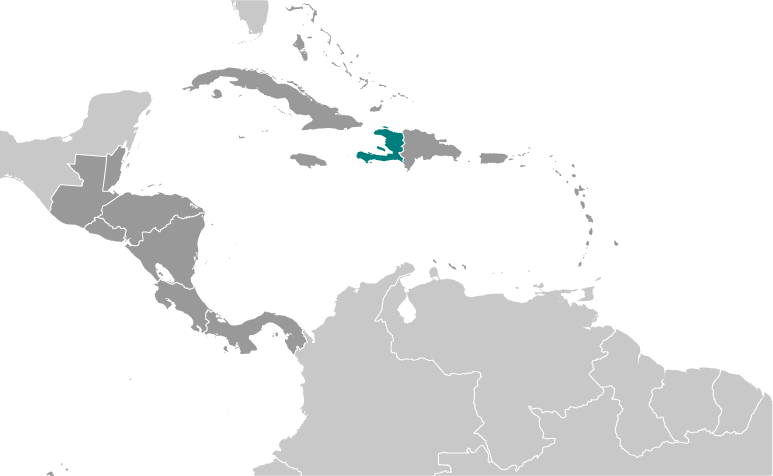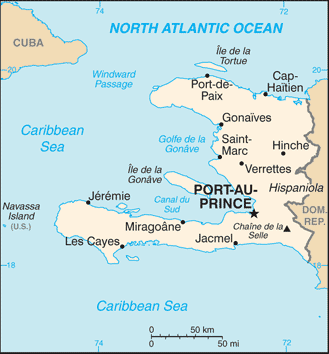
|
|
Advertisements:
EconomyEconomy - overview
Haiti is a free market economy that enjoys the advantages of low labor costs and tariff-free access to the US for many of its exports. Poverty, corruption, and poor access to education for much of the population are among Haiti's most serious disadvantages. Haiti's economy suffered a severe setback in January 2010 when a 7.0 magnitude earthquake destroyed much of its capital city, Port-au-Prince, and neighboring areas. Already the poorest country in the Western Hemisphere with 80% of the population living under the poverty line and 54% in abject poverty, the earthquake inflicted $7.8 billion in damage and caused the country's GDP to contract 5.4% in 2010. Following the earthquake, Haiti received $4.59 billion in internatioonal pledges for reconstruction, which has proceeded slowly. Two-fifths of all Haitians depend on the agricultural sector, mainly small-scale subsistence farming, and remain vulnerable to damage from frequent natural disasters, exacerbated by the country's widespread deforestation. US economic engagement under the Haitian Hemispheric Opportunity through Partnership Encouragement (HOPE) Act, passed in December 2006, has boosted apparel exports and investment by providing duty-free access to the US. Congress voted in 2010 to extend the legislation until 2020 under the Haiti Economic Lift Program Act (HELP); the apparel sector accounts for about 90% of Haitian exports and nearly one-tenth of GDP. Remittances are the primary source of foreign exchange, equaling nearly 20% of GDP and more than twice the earnings from exports. Haiti suffers from a lack of investment, partly because of limited infrastructure and a lack of security. In 2005, Haiti paid its arrears to the World Bank, paving the way for reengagement with the Bank. Haiti received debt forgiveness for over $1 billion through the Highly-Indebted Poor Country initiative in mid-2009. The remainder of its outstanding external debt was cancelled by donor countries following the 2010 earthquake but has since risen to over $600 million. The government relies on formal international economic assistance for fiscal sustainability, with over half of its annual budget coming from outside sources. The MARTELLY administration in 2011 launched a campaign aimed at drawing foreign investment into Haiti as a means for sustainable development. Gdp (purchasing power parity) World Ranking: 147
$12.52 billion (2011 est.)
$11.86 billion (2010 est.) $12.54 billion (2009 est.) Note Data are in 2011 US dollars Gdp (official exchange rate)
$7.388 billion (2011 est.)
Gdp - real growth rate World Ranking: 54
5.6% (2011 est.)
-5.4% (2010 est.) 2.9% (2009 est.) Gdp - per capita (ppp) World Ranking: 205
$1,300 (2011 est.)
$1,200 (2010 est.) $1,300 (2009 est.) Note Data are in 2011 US dollars Gdp - composition by sector
Agriculture 25%
Industry 16% Services 59% (2010 est.) Labor force World Ranking: 79
4.81 million
Note Shortage of skilled labor, unskilled labor abundant (2010 est.) Labor force - by occupation
Agriculture 38.1%
Industry 11.5% Services 50.4% (2010) Unemployment rate World Ranking: 187
40.6% (2010 est.)
Note Widespread unemployment and underemployment; more than two-thirds of the labor force do not have formal jobs Population below poverty line
80% (2003 est.)
Household income or consumption by percentage share
Lowest 10% 0.7%
Highest 10% 47.7% (2001) Distribution of family income - gini index World Ranking: 7
59.2 (2001)
Investment (gross fixed) World Ranking: 42
25% of GDP (2010 est.)
Budget
Revenues $1.485 billion
Expenditures $1.658 billion (2011 est.) Taxes and other revenues World Ranking: 163
20.1% of GDP (2011 est.)
Budget surplus (+) or deficit (-) World Ranking: 83
-2.3% of GDP (2011 est.)
Inflation rate (consumer prices) World Ranking: 181
8.5% (2011 est.)
5.7% (2010 est.) Commercial bank prime lending rate World Ranking: 28
11.61% (31 December 2011 est.)
17.5% (31 December 2010 est.) Stock of narrow money World Ranking: 131
$1.786 billion (31 December 2011 est.) $833.1 million (31 December 2010 est.) Stock of broad money World Ranking: 136
$3.43 billion (31 December 2011 est.) $3.269 billion (31 December 2010 est.) Stock of domestic credit World Ranking: 135
$1.967 billion (31 December 2011 est.) $1.728 billion (31 December 2010 est.) Market value of publicly traded shares
$NA
Agriculture - products
Coffee, mangoes, sugarcane, rice, corn, sorghum; wood Industries
Textiles, sugar refining, flour milling, cement, light assembly based on imported parts Industrial production growth rate World Ranking: 160
-4.8% (2010 est.)
Electricity - production World Ranking: 153
650 million kWh (2010 est.)
Electricity - consumption World Ranking: 167
309 million kWh (2010 est.)
Electricity - exports
NA kWh (2010 est.)
Electricity - imports
0 kWh (2010 est.)
Oil - production World Ranking: 181
0 bbl/day (2010 est.)
Oil - consumption World Ranking: 147
12,000 bbl/day (2010 est.)
Oil - exports World Ranking: 163
0 bbl/day (2009 est.)
Oil - imports World Ranking: 135
13,480 bbl/day (2009 est.)
Oil - proved reserves World Ranking: 141
0 bbl (1 January 2011 est.)
Natural gas - production World Ranking: 192
0 cu m (2009 est.)
Natural gas - consumption World Ranking: 187
0 cu m (2009 est.)
Natural gas - exports World Ranking: 112
0 cu m (2009 est.)
Natural gas - imports World Ranking: 203
0 cu m (2009 est.)
Natural gas - proved reserves World Ranking: 186
0 cu m (1 January 2011 est.)
Current account balance World Ranking: 146
-$2.105 billion (2011 est.)
-$1.956 billion (2010 est.) Exports World Ranking: 163
$721.3 million (2011 est.)
$561.5 million (2010 est.) Exports - commodities
Apparel, manufactures, oils, cocoa, mangoes, coffee Exports - partners
US 83.3% (2011)
Imports World Ranking: 141
$3.352 billion (2011 est.)
$2.809 billion (2010 est.) Imports - commodities
Food, manufactured goods, machinery and transport equipment, fuels, raw materials Imports - partners
Dominican Republic 31.9%, US 25.3%, Netherlands Antilles 8.7%, China 7.2% (2011) Reserves of foreign exchange and gold World Ranking: 125
$1.341 billion (31 December 2011 est.) $1.336 billion (31 December 2010 est.) Debt - external World Ranking: 162
$665.1 million (31 December 2011 est.) $482.1 million (31 December 2010 est.) Stock of direct foreign investment - at home World Ranking: 93
$603.3 million
$453.3 million Exchange rates
Gourdes (HTG) per US dollar -
40.523 (2011 est.) 39.8 (2010 est.) 42.02 (2009) 39.216 (2008) 37.138 (2007) Fiscal year
1 October - 30 September
Comments
Add a new comment: |
Advertisement
Members area
Haiti (Port-au-prince):
 
GPS points from Haiti (Port-au-prince)
|
||||||||

 The native Taino Amerindians - who inhabited the island of Hispaniola when it was discovered by Christopher COLUMBUS in 1492 - were virtually annihilated by Spanish settlers within 25 years. In the early 17th century, the French established a presence on Hispaniola. In 1697, Spain ceded to the French the western third of the island, which later became Haiti. The French colony, based on forestry and sugar-related industries, became one of the wealthiest in the Caribbean but only through the heavy importation of African slaves and considerable environmental degradation. In the late 18th century, Haiti's nearly half million slaves revolted under Toussaint L'OUVERTURE. After a prolonged struggle, Haiti became the first black republic to declare independence in 1804. The poorest country in the Western Hemisphere, Haiti has been plagued by political violence for most of its history. After an armed rebellion led to the forced resignation and exile of President Jean-Bertrand ARISTIDE in February 2004, an interim government took office to organize new elections under the auspices of the United Nations. Continued violence and technical delays prompted repeated postponements, but Haiti finally did inaugurate a democratically elected president and parliament in May of 2006. A massive magnitude 7.0 earthquake struck Haiti in January 2010 with an epicenter about 25 km (15 mi) west of the capital, Port-au-Prince. Over 300,000 people were killed and some 1 milllion left homeless. The earthquake was assessed as the worst in this region over the last 200 years.
The native Taino Amerindians - who inhabited the island of Hispaniola when it was discovered by Christopher COLUMBUS in 1492 - were virtually annihilated by Spanish settlers within 25 years. In the early 17th century, the French established a presence on Hispaniola. In 1697, Spain ceded to the French the western third of the island, which later became Haiti. The French colony, based on forestry and sugar-related industries, became one of the wealthiest in the Caribbean but only through the heavy importation of African slaves and considerable environmental degradation. In the late 18th century, Haiti's nearly half million slaves revolted under Toussaint L'OUVERTURE. After a prolonged struggle, Haiti became the first black republic to declare independence in 1804. The poorest country in the Western Hemisphere, Haiti has been plagued by political violence for most of its history. After an armed rebellion led to the forced resignation and exile of President Jean-Bertrand ARISTIDE in February 2004, an interim government took office to organize new elections under the auspices of the United Nations. Continued violence and technical delays prompted repeated postponements, but Haiti finally did inaugurate a democratically elected president and parliament in May of 2006. A massive magnitude 7.0 earthquake struck Haiti in January 2010 with an epicenter about 25 km (15 mi) west of the capital, Port-au-Prince. Over 300,000 people were killed and some 1 milllion left homeless. The earthquake was assessed as the worst in this region over the last 200 years.